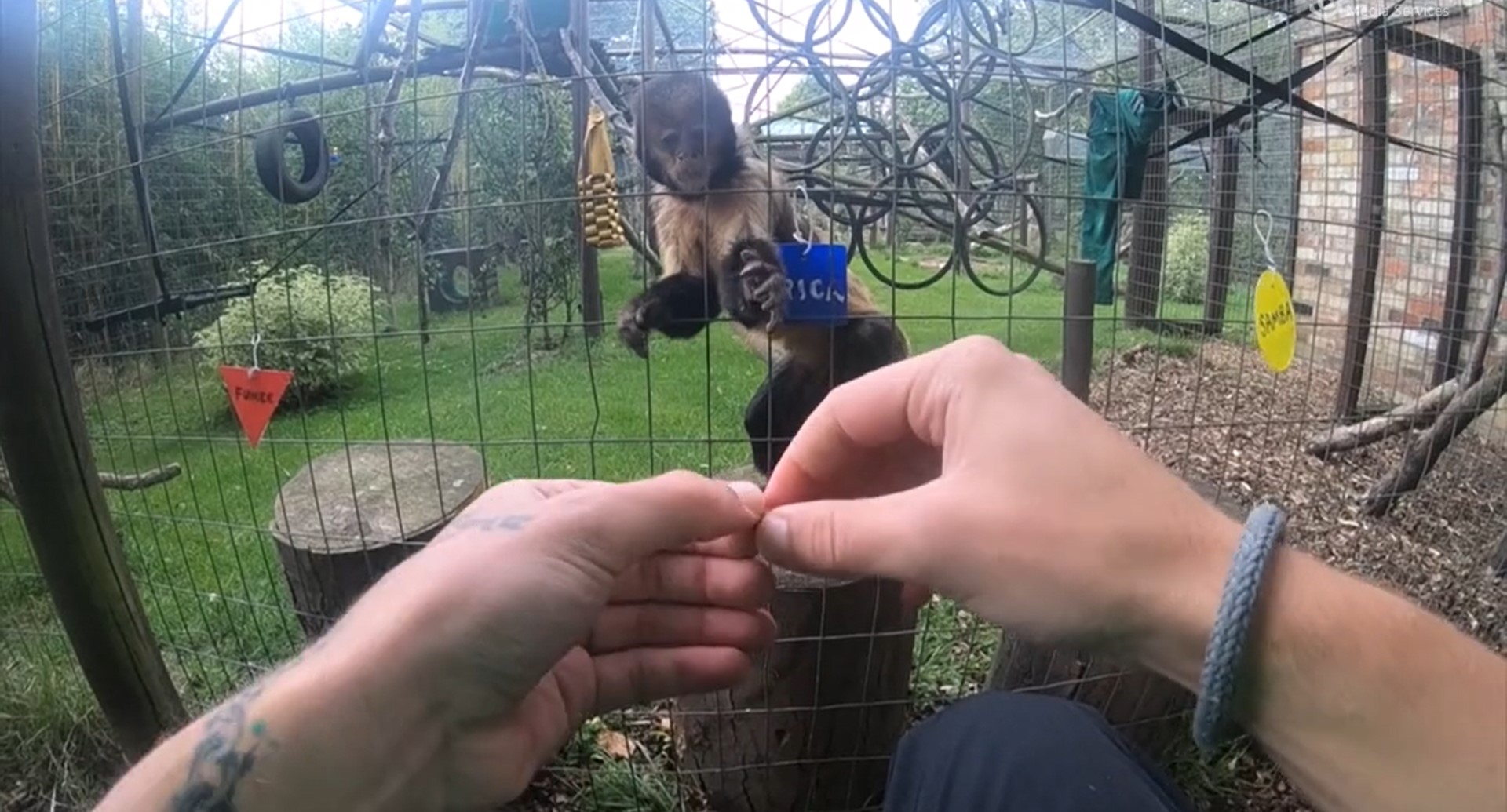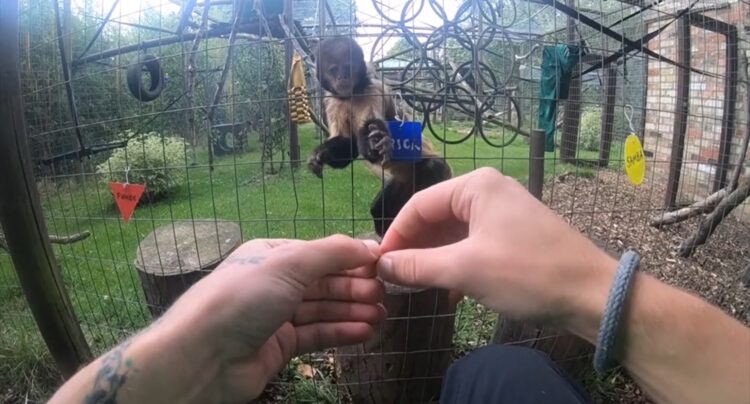By performing a famous magic trick for three species of monkey with differing hand structures, scientists have discovered that – in order to deceive – a conjuror needs a similar anatomy to their audience.

Credit: Dr Elias Garcia-Pelegrin
By performing a famous magic trick for three species of monkey with differing hand structures, scientists have discovered that – in order to deceive – a conjuror needs a similar anatomy to their audience.
Psychologists used a sleight-of-hand trick called the French drop, in which an object appears to vanish when a spectator assumes it is taken from one hand by the hidden thumb of the other hand.
The study, carried out at the University of Cambridge’s Comparative Cognition Lab, found that monkeys lacking opposable thumbs did not fall for the assumption – staying wise to the whereabouts of tasty treats a magician tried to make disappear.
The research suggest that sharing a biomechanical ability may be necessary for accurately anticipating the movements of those same limbs in other individuals.
This is true even when those apparently accurate predictions end in befuddlement at the hands of an illusionist. The study is published today in the journal Current Biology.
“Magicians use intricate techniques to mislead the observer into experiencing the impossible. It is a great way to study blind spots in attention and perception,” said Dr Elias Garcia-Pelegrin, who has practiced magic for a decade, and conducted the experimental work during his PhD at Cambridge.
“By investigating how species of primates experience magic, we can understand more about the evolutionary roots of cognitive shortcomings that leave us exposed to the cunning of magicians.”
“In this case, whether having the manual capability to produce an action, such as holding an item between finger and thumb, is necessary for predicting the effects of that action in others,” said Garcia-Pelegrin, recently appointed an assistant professor at the National University of Singapore.
The French drop is often the first trick any budding magician sets out to master.
A coin is displayed in one hand. The other hand reaches over and grabs it. The palm of the second hand faces inwards, with the magician’s thumb concealed behind fingers.
The audience knows the thumb is lurking – ready to grip – so assumes the coin has been taken when it is no longer visible. Their attention follows the second hand, only to find it empty at “the reveal”. The magician had secretly dropped the coin into the palm of the original hand.
Food morsels replaced coins for the monkeys, and were given as rewards – but only if the animals guessed the correct hand. Scientists predicted that monkeys with opposable thumbs would act like human audiences: assume the hidden thumb had grabbed the item, and choose the wrong hand.
They repeatedly performed the French drop on 24 monkeys. Eight capuchins were dazzled with peanuts, eight squirrel monkeys with dried mealworms, and eight marmosets with marshmallows.
Capuchins are famed for dexterity, and use stone tools to crack nuts in the wild. They can waggle each finger, and have opposable thumbs allowing “precision grip” between thumb and forefingers.
The capuchins were regularly fooled by the French drop (81% of the time). They mostly chose the empty second hand, and experienced a paucity of peanuts as a result.
Squirrel monkeys are much less dextrous than capuchins, with limited thumb rotation, but can oppose their thumbs. As such, they are still familiar with a hidden thumb interacting with fingers. However, they cannot perform a ‘precision grip’ in the same way as capuchins and humans.
Yet squirrel monkeys were routinely misled by mealworms that seemingly vanished (fooled 93% of the time). “Squirrel monkeys cannot do full precision grips, but they were still fooled. This suggests that a monkey doesn’t have to be expert in a movement in order to predict it, just roughly able to do it,” said Garcia-Pelegrin.
Marmosets do not have opposable thumbs. Their thumbs align with their fingers to make five equidistant digits, ideal for climbing thick tree trunks. Marmosets were rarely taken in by magic (just 6% of the time). They simply chose the hand in which the marshmallow was initially placed, and stuck with it.
Previous work from the Cambridge team shows that species without hands at all, in this case birds from the corvid family, namely Eurasian jays, make similar choices as marmosets when confronted with the French drop.
The team also tried nullifying the tricks by actually completing the hand-to-hand transfers, instead of misdirecting with a French drop. This time, the capuchins and squirrel monkeys anticipated correctly and dined out, and the marmosets missed out.
Finally, the scientists devised their own version of the French drop, which they call the “Power drop”. It utilises a hand action that all the monkey species can perform – essentially a full fist grab. The power drop fooled all of the monkey species the vast majority of the time.
“There is increasing evidence that the same parts of the nervous system used when we perform an action are also activated when we watch that action performed by others,” said Prof Nicola Clayton FRS, senior author of the study from Cambridge’s Department of Psychology.
“This mirroring in our neural motor system might explain why the French drop worked for the capuchins and squirrel monkeys but not for marmosets.”
“It’s about the embodiment of knowledge,” added Clayton. “How one’s fingers and thumbs move helps to shape the way we think, and the assumptions we make about the world – as well as what others might see, remember and anticipate, based on their expectations.”
“Our work raises the intriguing possibility that an individual’s inherent physical capability heavily influences their perception, their memory of what they think they saw, and their ability to predict manual movements of those around them.”
Another co-author of the study, Clive Wilkins, Artist in Residence at Cambridge’s Department of Psychology, is a professional magician and Member of the Magic Circle.
Journal
Current Biology
DOI
10.1016/j.cub.2023.03.023
Article Title
Manual action expectation and biomechanical ability in three species of New World monkey
Article Publication Date
4-Apr-2023





